Click photos to enlarge

Socorro County Historical Society
Socorro, New Mexico, USA

History
Articles
J. S. "Old Hutch" Hutchison staked the Graphic (and Juanita) mines in 1866, which he worked until selling the Graphic mine circa.
1878 to the firm of Hanson & Dawson for $30,000 (about $700,000 today). Around 1900, Cony T. Brown discovered a bluish
rock discarded in the Graphic tailings that proved to be the rare and valuable Smithsonite. Partnering with friend James
Fitch, also of Socorro, the two leased, then purchased, the Graphic mine. In 1904, Fitch & Brown sold the Graphic mine to theSherwin-Williams Paint Co. for $150,000 (about $3.5 million today) comprising claims over 227 acres, renaming their enterprise
the Ozark Smelter & Mining Co.
In 1906, the new Ozark Co. drove the
Waldo tunnel to reach the deeper levels of the ore,
eventually mining into the Graphic property. The Graphic and Waldo mines are only about 1,000 feet apart, becoming somewhat
a single mining operation.
The mine above level 6 was traditionally called the Graphic mine and all levels below that theWaldo mine. Due to mining the same ore body, they were often called the
Graphic-Waldo mine in reports and literature with
lead, zinc, and silver the dominant ores. Nearby is the
Nitt mine, also working the same ore body.
The mine was closed in
1929 and reopened in 1937 on a limited basis. It provided "war metals" and throughout WWII.
The Graphic-Waldo
mine includes 14 levels accessed by several tunnels and one shaft. Level 3 connects through a stope to level 4 of the
Kelly mine,
a distance of about 1,700 feet. Level 4 is opened through the Ida Hill tunnel. Levels 10 and 11 follows the “silver pipe” bed and
extends into the
Nitt mine workings.
The Graphic-Waldo and Nitt mines appears the only Kelly area mines whose
ores are not depleted and has been worked on and off ever since. The underground workings remain open and accessible should
the mines be reopened for future production. The Graphic-Waldo mine is currently owned by ASARCO - the American Smelting and
Refining Co., a subsidiary of Grupo Mexico. Due to it's active, though idle, mine status, it remains private property and no
trespassing posted.
NOTE: The Graphic-Waldo Mine is PRIVATE PROPERTY, owned by ASARCO/Grupo Mexico Corp.
Posted NO TRESPASSING.
Early photos of the Graphic-Waldo mine at Kelly, New Mexico
The concrete foundations and remnants
of the Graphic Smelter and Mill
(Ozark mill) near Kelly, NM
At junction of Kelly road and Hop Canyon road
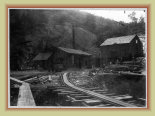
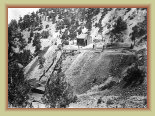
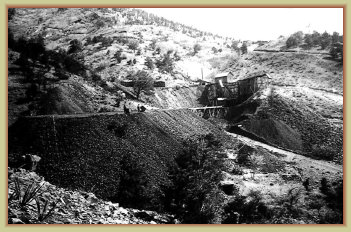
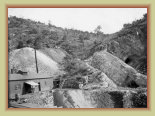
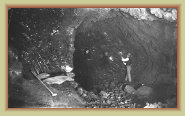
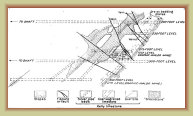
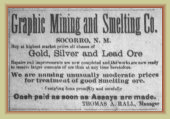
Inside the mine
Some of the tunnels & veins of the Graphic-Waldo mine
An ad for the mine and smelter in the Socorro Chieftain newspaper
The Graphic Mine
The Graphic Mill was built in 1896 about 1˝ miles west of Kelly to process about 100 tons of ore daily from the Graphic mine.
In 1904,
the Graphic mine and mill was purchased by the Sherwin-Williams Paint Co., changing their name to Ozark Smelting & Mining
Co. in 1906. Ore from the combined Graphic-Waldo mine was run down the mountain to the railroad terminal at the Graphic smelter on
a 36-inch tram by gravity; empty ore cars were returned to the mine up the mountain by horse. Ore from other Kelly area mines
was delivered to the Graphic smelter by 4-horse, 5-ton ore wagons.
The Graphic mill was closed in 1909 while installing a new
flotation process for the zinc ores and reopened early 1910. The mill was expanded again in 1912 to increase capacity. By 1913, the
Ozark Smelting & Mining Co. was the largest zinc producer in the region.
The Graphic mill was destroyed by fire on August 10,
1916 and immediately rebuilt to respond to the lead and zinc demands for WWI. The economic depression following the war forced
the mill to sit idle 1922 through 1925, though the Graphic-Waldo mine remained in production. The mill returned to operation on Feb.
15, 1926 processing 125 tons of low grade zinc ore daily. In 1927, a new ball mill was installed for finer grinding of the ore to
increase the percentage of zinc concentrates. However, the mill was closed again late 1927.
With the Tri-Bullion mill at the
Kelly mine also closed, the Black Cloud mill, processing mostly lead carbonate ore, was the only mill in the region left in operation.
It closed in 1928 due to diminishing ore and a weak market - becoming the last mill in the Magdalena-Kelly mining district to
cease operation.
During the early 1930s, the Graphic, Tri-Bullion and Black Cloud mills were dismantled, equipment removed or
sold, and the properties abandoned. Today, only the extensive concrete foundations of the Graphic (Ozark) mill, and the
concrete pedestals once supporting the milling and smelting machinery, remain. The Graphic mill ruins are located at the junction
of the road to Hop Canyon with the Kelly road.
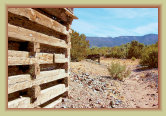
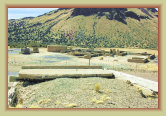
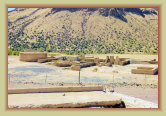
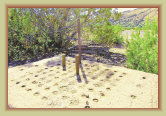
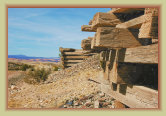

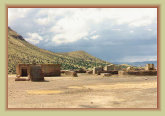
Building the ore shoots
for the aerial tram
circa. 1906
The ore shoots as they appear today.
The Kelly Mine & Traylor Shaft
SCHS photos except where noted
Some of the remnants of the Waldo mine with the Graphic mine headframe on far right.
Nitt mine not visible in this view.
Links:
!
Have photos? If you have photos of the Kelly mining district or of family that worked the mines you'd like to share,
please let us know here and we'll add them to these pages.
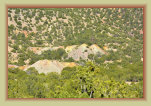
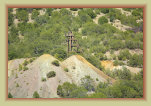
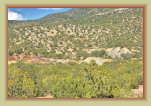
Graphic mine
head frame
4
0723d
Mines
On this page:
THE WALDO MINE
and the GRAPHIC MILL


















